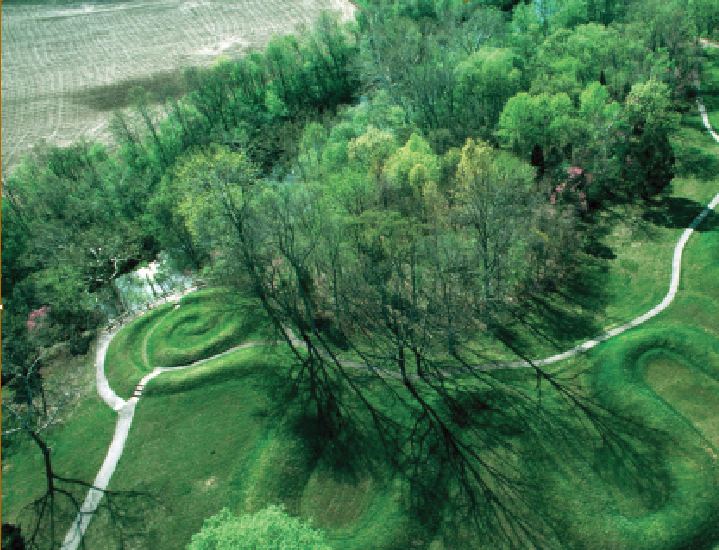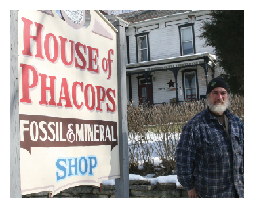Officially Serpent Mound is the largest surviving prehistoric effigy mound in the world, but in this stranger-than-fiction story, there are ardent supporters for all of the claims listed above, and many more.
According to the Ohio Historical Society, the organization that manages the site in rural in southern Ohio, the mound is over 1,300 feet long, and clearly resembles an uncoiling serpent. Their website says the original purpose of the mound is unknown but was probably built by people from the Fort Ancient culture who lived in the area from 1000 to 1500 A.D. Bradley Lepper, archaeologist for the society, reports that the head of Serpent Mound appears to align with the rising sun during the summer solstice, and since the nearby Newark Earthworks have detailed astronomical alignments built into them, it is reasonable to assume that Serpent Mound does as well. Generations of researchers agree with that theory, but the intent of those who built the serpent remains a mystery. Lepper posits that Serpent Mound may have been a shrine to a spiritual power.
The mound is on the National Register of Historic Places and is being considered as a U.S. nominee to the UNESCO World Heritage sites. According to Glenna J. Wallace, chief of the Eastern Shawnee Tribe of Oklahoma, the Shawnee consider Serpent Mound a sacred site. The Eastern Shawnee were originally from Ohio but left the area along with several other tribes as part of the federal Indian Removal Act of 1830. Nine tribes removed from Ohio settled on reservations in Oklahoma; by about 1850, most had officially been "removed." Today, there are no federally recognized tribes in Ohio. "Although we don't claim that we built Serpent Mound, historically we respected and protected the various mounds and earthworks in Ohio," says Wallace.
In recent years, Serpent Mound has become a mecca for New Agers. A story in the The Columbus Dispatch last year offered a glimpse into that world. The headline for the story declared, vandals admit muffin-crystal-thingie assault at serpent mound. According to the story, a group of people from the organization Unite the Collective posted a video showing people burying "what may be" hundreds of small muffin-shaped devices called orgonites in the mounds, hoping they were "[lifting] the vibration of the earth so we can all rise together." They describe themselves as Light Warriors.
Orgonites are homemade objects composed of resin and bits of metal and crystal. A number of websites claim orgonites draw in negative energy and emit positive energy. In the 1930s, the controversial Austrian inventor Wilhelm Reich "discovered" orgone; he claimed it was the life energy that fueled all living things. He created and sold "orgone accumulators" he claimed could concentrate and direct this life energy. There were a few skeptics: In 1954, the U.S. Food and Drug Administration declared orgone accumulators and "orgonomy" - the study of orgone - to be a sham, and Reich was tried for making false and misleading claims. He was sentenced to two years in jail, and the Food and Drug Administration ordered all accumulators rented or owned by him destroyed. Despite that bit of unpleasantness, orgonomy continues to have a devoted following.
The burying of those "crystal thingies" was just the latest in a long list of unusual New Age activities at Serpent Mound. Authorities from the Ohio State Historical Society have been tolerant of these doings so long as no damage has been done to the mound. The activities of the self-described light warriors, however, went too far. According to the Courier piece, Unite the Collective placed a video on YouTube that showed several people running and jumping over the mounds, and declared in the video (entitled "Serpent Mound Reactivation 2012") that they spent several days planting orgonites in Serpent Mound in order to "reactivate" it. The link to the YouTube video has since been taken down from the Unite the Collective website.

In the video, the light warriors reportedly claimed to have buried hundreds of orgonites in the mound. So far, however, authorities have found only a few. According to Lepper, the society is planning to use a police dog to locate the remaining orgonites. "Our hope is that prosecuting these [vandals] will prevent others from doing these sorts of activities," he said.
According to Serpent Mound gift-shop manager Megan McCane, burying or placing items in and around the mound has gone on for quite some time. Volunteers and workers routinely remove items placed in the mound. To discourage the burial of objects, workers have designated a place nearby for people to leave such offerings.
Lepper says various New Age ceremonies began in earnest at Serpent Mound around the time of the Harmonic Convergence in August 1987. Believers all over the world marked that event by gathering, chanting and meditating at various sites deemed powerful. "Thousands of people came to Serpent Mound during the convergence," Lepper recalls.
Since then, numerous New Age ceremonies, gatherings and festivals have become popular events at Serpent Mound.
An Alien Gas Station?
Some of the extreme interpretations about why the mounds were built are supported by such unlikely sources as the History Channel, which ran a series, Ancient Aliens, that purports to prove extraterrestrial beings inhabited or visited Earth in ancient times. In 2011, the show featured Serpent Mound and offered evidence that allegedly shows that the site was a landing area for aliens, who frequently visited Serpent Mound to mine iridium, a rare element, to fuel their ships.
The show's producers conducted numerous interviews with local experts as well as supporters of various New Age interpretations of the mounds, including Lepper, who now regrets participating. "The producers spent a long time interviewing me, but in the actual show they feature a seconds-long quote in which I say, 'Serpent Mound must have been special,' then they jump to another source saying that the mound was built by aliens."
Local owner of the House of Phacops Museum Tom Johnson was presented in the show as an expert on both Serpent Mound and local Native people. In his interview, he says, "the Shawnee are convinced that space travelers are using Serpent Mound as a marker."
The House of Phacops is a rock shop that offers trilobites [a local fossil] minerals and crystals for sale. Johnson is a former factory worker from Michigan, a trilobite enthusiast and an advocate for New Age activities at Serpent Mound. According to one of the Museum's brochures, he also offers information about local travel to sacred places, including Serpent Mound. A local citizen's organization, "Friends of Serpent Mound," coordinates a number of events popular among New Age followers such as spring equinox and summer solstice celebrations. Events feature drumming, sweat lodges, healing ceremonies as well as presentations by authors such as Ross Hamilton who wrote The Mystery of Serpent Mound: In Search of the Alphabet of the Gods. According to the publisher's online information, the book draws on historical, linguistic, archaeological, and occult sources in describing the secret knowledge hidden in the mound.
Sacred Destinations, a website dedicated to showcasing sacred places for "spiritual pilgrimage" features Serpent Mound among its more than 1,200 such sites. According to the website's description, "Some New Age practitioners have suggested that Serpent Mound is patterned on the Little Dipper constellation, which could indicate a cosmic energy flow between heaven and earth. Others have analyzed the mounds (along with others in the area) for ley lines, which are believed to conduct healing energy between ancient sacred sites. New Age groups and individuals often use the site for meditation."
A local healer who calls himself "Three Eagles" and claims Cherokee heritage frequently participates in New Age gatherings at the mound. Three Eagles, who took the name after seeing three eagles in one day, cuts negative energy away from people by making cutting motions close to the body with a large bowie knife. He claims to have been taught the skill by another man trained in Tibetan healing techniques who used Tibetan swords to cut away negative energy. Using a bowie knife, according to Three Eagles, makes the technique more Indian. Other demonstrations and workshops held at Serpent Mound examine alleged crop circles in the area and provide training in dowsing for water.
The Crystal Skull Festival brought people from around the world to Serpent Mound in 2011. The festival brought together 13 ancient crystal skulls at Serpent Mound in 2011 for a ceremony intended to ignite paranormal powers at the site. According to a story in The Columbus Dispatch, the ceremony also brought together several Mayan priests who were to discuss the end of the world prophesied by the Mayan calendar in 2012. Followers of the crystal skulls prophecy believe that the skulls are pre-Columbian Mesoamerican artifacts created by the Aztecs or Mayans and will exhibit paranormal powers if brought together in one place. Researchers such as Jane MacLaren Walsh, an anthropologist with the Smithsonian have found that the skulls likely were produced during the second half of the 19th century in Europe and Mexico. The skulls have no proven connection to any pre-Columbian culture she notes in an article in Archaeology magazine.
Longtime resident and earthworks enthusiast Geoffrey Sea noted something weirdly familiar about much of the terminology used by New Age groups - such as "intergalactic portals" - and the notion that secret elements were being mined at Serpent Mound. "Why do I know this?" wondered the local historian and researcher. "There is an element of cheesy science fiction that runs through all of this." He finally realized that much of the New Age terms relating to Serpent Mound and the "light warriors" seems to come from the 1994 film Stargate. According to Sea, the film's story line features space travelers who enter a giant portal that, once activated, zaps them across the galaxy, where they encounter an alien civilization that looks like ancient Egypt. The aliens are mining a secret element used to power space ships.
Mining for New Age Dollars
For economically depressed Adams County, cashing in on New Age interest in Serpent Mound could be lucrative. Recreating the area as a New Age travel destination could benefit the local economy. For instance, nearby Hocking Hills county has emerged as a travel destination in recent years. Similar to Adams, Hocking Hills' economy offered little for residents in terms of jobs. Recently, however, Hocking Hills has recreated itself as the "Hot tub capital of the Midwest," according to chamber of commerce materials. Hocking Hills is now home to many local businesses featuring popular vacation getaways in the form of cabins with hot tubs.
The New Age dollar would seem to be worth pursuing. According to a 2009 study conducted by the Pew Forum on Religion & Public Life, 26 percent of American adults follow some sort of New Age practice or belief. The Unite the Collective website offers a number of orgonites and wands for sale, some for hundreds of dollars. Even the struggling nonprofit Arc of Appalachia, responsible for managing and funding the daily operations of Serpent Mound site, offers numerous New Age books for sale at the mound bookstore. Until recently, the shop also sold orgonites created by a local artist, but McCane says, "They really didn't sell very well."
Kenny Frost a Southern Ute citizen, has worked to protect sacred places for more than 20 years. He is a well-respected authority on Native American Graves Protection and Repatriation Act issues and law and frequently consults with state, federal and tribal governments. "The protection put down by Native people at sacred sites is still there. Non-Native people dig around and see what they can find; they may end up opening a Pandora's box without knowing how to put spirits back," he notes.
Native people, on the other hand, are taught to respect sacred places honoring them with simple prayer and respect.
The Old-Age Perspective
Ironically, Serpent Mound's strange role as repository for outlandish activities and beliefs may be partially due to the lack of Natives in Ohio. Since there is no public information tying Serpent Mound to contemporary Native tribes, many people freely bring their interpretations to the mound, notes Marti L. Chaatsmith, Comanche, director of the nearby Newark Earthworks Center of Ohio at the Ohio State University at Newark. She agrees with Lepper and Wallace that an explanation of the importance of sacred places for Native peoples as well as descriptions of appropriate ways to treat these sites are sorely needed there, and scoffs at stories of space aliens at Serpent Mound: "Serpent Mound was not built by aliens or lost tribes; it was built by American Indians."
Lepper also believes that ancestors of American Indians built Serpent Mound and the nearby Newark Earthworks. Although contemporary tribes have no specific stories relating to the mound, it doesn't mean their ancestors didn't build them - he says it "is tragic that dislocation severed their ties to the mounds and earthworks."
Members of the Eastern Shawnee tribe are fighting to reconnect with their homeland and work with organizations like the Newark Earthworks Center and Ohio Historical Society to create educational programming that can be presented to the public at venues like Serpent Mound according to Wallace.
Although many people purport to know about the history of the Shawnee in Ohio and seek to represent them, they have little information about the tribe today Wallace explains. Local groups with limited connection to the Shawnee often misrepresent facts about the tribe such as Johnson's claim that the Shawnee believe that space travelers used Serpent Mound as a marker.
The Earthworks Center is hosting a conference this summer during which Wallace and a group of Eastern Shawnee people will return to their homelands. During the visit they plan to share information about their spiritual and cultural connections with the Earthworks with the public. Wallace, Lepper and Chaatsmith hope they can offer an important indigenous perspective on such sites. "The Shawnee are ancestrally related to the builders of the mounds and can speak for them on their behalf," says Lepper, who argues that excluding indigenous perspectives and input in treatment of such sites seems damaging and demeaning to Native peoples.
"These types of New Age activities" - like burying orgonites - "do indeed concern us, but much of our struggle here in Oklahoma has focused on our physical survival," Wallace says. "We are working with authorities in Ohio to preserve these sacred sites. We are following the legacy of our ancestors who respected and preserved the earthworks."
For Lepper, growing New Age interest in Serpent Mound presents a double-edged sword. He acknowledges the untapped tourism potential presented by New Age visitors and is pleased with the growing interest in the mound. Activities that include walking on and burying things in the mound and conducting unusual ceremonies, however, only serve to trivialize the importance of a sacred indigenous site - "Not only do such activities damage the mound, they demean the connection that Indigenous Peoples have to this sacred site."






My thought is that it is a walking maze like other spiral mazes found around the world may be. You could easily weave along one edge spiral into the middle and then walk back out on a different edge ready to complete the circuit again. Maybe it was built upon some sort of earth phenomenon that would facilitate increasing a type of energy if you did this repetitively ?? Just an idea...